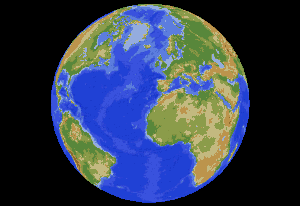 |
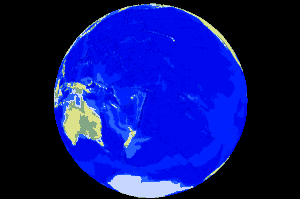 |
| . |
Oceanography: Oceanscontinental drift and the origins of oceanswww.seafriends.org.nz/oceano/oceans.htm
|
 |
 |
Because most of the land is found in the Northern Hemisphere, the two
hemispheres behave very differently in response to annual variation in
solar radiation. The stabilising effect of the oceans makes that the Southern
Hemisphere has smaller temperature differences between winter and summer,
resulting in less wind and more temperate winters and summers (See Temperature,
below). It may also explain why the large Pacific Ocean is more tranquil
than the smaller Atlantic Ocean.
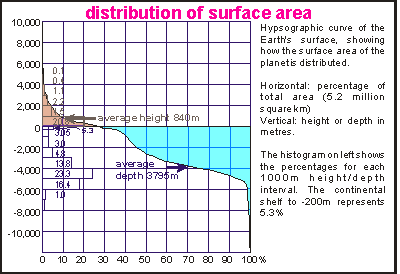 Distribution
of surface area Distribution
of surface area
Most maps of the planet show height contours. These are hypsographic maps (Gk hypsos = height). When all height contours of both sea and land are put together, the hypsographic curve results as shown here. It gives an immediate overview of the distribution of height and depth over the planet. Horizontally is the surface area of the planet as a percentage of the total (5.2 million km2). The seas occupy just over 70% and the land just under 30%. The amount of land above sea level (brown) is very much less than the volume of sea (blue). If the land was spread into the sea, the oceans would still be 3000m deep! The highest point on land is Mount Everest (8848m). The deepest point in the ocean is in the Mariana Trench (11034m) |
The diagram gives us an idea of the general shape
of the ocean basin. Only a very small part goes deeper than 6000m and the
deepest troughs of 10km are hardly visible here, likewise for the land
and its tallest mountains. The most important bits are almost invisible
on this diagram: the land up to 500m where most of the people live and
the sea down to 200m where most of the ocean's productivity is found. From
this small margin of about 12 + 5 = 17%, the world population feeds itself.
Click here for a larger diagram.
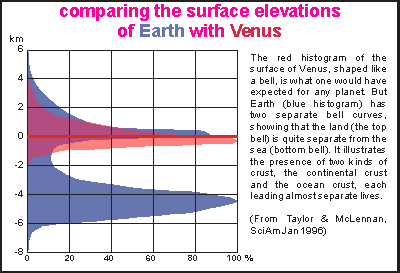 In
the lefthand margin of the hypsographic curve above, a histogram is shown
of the distribution of height of Earth's surface, and this curve is shown
in more detail here. The zero axis (red line) is sea level but not average
height. Since the Magellan space probe mapped the landscape of Venus
accurately in 1990, the two surface areas can be compared. The red curve
is that of Venus, centred around its average height because Venus has no
oceans. It is a bell shaped curve as can be expected from any planet, but
it differs remarkably from Earth's. In
the lefthand margin of the hypsographic curve above, a histogram is shown
of the distribution of height of Earth's surface, and this curve is shown
in more detail here. The zero axis (red line) is sea level but not average
height. Since the Magellan space probe mapped the landscape of Venus
accurately in 1990, the two surface areas can be compared. The red curve
is that of Venus, centred around its average height because Venus has no
oceans. It is a bell shaped curve as can be expected from any planet, but
it differs remarkably from Earth's.
Either the oceans have carved a deep dent into the smooth bell of Earth's crust, or we must assume that the crust consists of two separate parts, the continents and the ocean basins. As we shall see later, this is the case. |
| planet | distance
from sun million km |
diameter
km |
mass
relative to Earth |
rotation
period |
orbit
period |
mean
temp ºC |
atmosphere
and ocean |
| Mercury | 57.9 | 4878 | 0.055 | 58.6d | 0.24y | -170 to 430 | Na |
| Venus | 108.2 | 12104 | 0.815 | -243d | 0.62y | -23 to 480 | CO2+N |
| Earth | 149.6 | 12756 | 1.000 | 23.94h | 1.00y | 16 | N+O+H2O |
| Mars | 227.9 | 6787 | 0.107 | 24.62h | 1.88y | -50 | CO2+N+Ar |
| Jupiter | 778.3 | 142800 | 317.8 | 9.93h | 11.86y | -150 | H+He+CH4+NH3 |
| Saturn | 1429 | 120000 | 95.2 | 10.5h | 29.48y | -180 | H+He+CH4+NH3 |
| Uranus | 2875 | 50800 | 14.5 | -17.24h | 84.01y | -210 | H+He+CH4 |
| Neptune | 4504 | 48600 | 17.2 | 16h | 164.8y | -220 | H+CH4+He? |
| Pluto | 5900 | 2245 | 0.002 | 6.4d | 247.71y | -230 | CH4? |
| Origin of the oceans
The origin of the oceans has puzzled people for a very long time, and even today, the issue has not been completely settled. The biblical view, expressed in the chapter Genesis, has held until last century, when other theories began to surface as a result of scientific knowledge. We'll have a look at some of these. |
The biblical perspective
It is interesting to note that, according to the chapter Genesis, heaven and earth with the seas were created in one swoop at the very first step, yet again in the second and third day. |
| The cooling atmosphere
The knowledge that the earth must once have been red hot, judged by lava spewing from volcanoes, made people think that the oceans must have originated from steam in the atmosphere. As the world cooled, it rained for thousands of years until the oceans were formed, so they thought. But there's a problem with this idea. The pull of gravity of this planet is just enough to keep an atmosphere together whose weight is no more than ten metres of water. So even if the old atmosphere consisted entirely of steam, the oceans would have filled only to a mere ten metres, rather than 3800. Scientist estimate the amount of water escaping from the early hot planet at 1.6E9 km3, whereas the volume of today's oceans is 5.2E9 km3 (W W Ruby, 1951). |
| Steam from the interior
Today most authors believe that early steam from the hot mantle but already cool atmosphere, caused the oceans in the very early stages of the planet. They reason from studies of chondrites (space rocks) in space that under compression, enough water could be released to form an ocean. Today one can observe the gases escaping from active volcanoes, and these too contain water. In this scenario, the oceans would still be increasing in size, a gradual process that would never really end. But why did the continental crust expand suddenly about 3 eons ago? (see below) The amount of water stored in rocks of the primary lithosphere is estimated at 25E21kg (Hutchinson G E, 1957), whereas the water in all oceans is 1.35E21kg, so it is quite possible that all this water emerged slowly after rocks were compressed and heated while the atmosphere had cooled already. |
| Debris from space
From the ratios of certain elements, scientists now agree that earth and the other planets in our solar system were formed by accretion from interstellar or cosmic debris (dust), left over from the explosion of a supernova star in our galaxy. Look at the moon and its many craters, each a remnant of a collision with a large object. The sun gathered most of it, growing to a size sufficiently large to become a nuclear fusion reactor. Our planet grew in size and started to heat up due to the falling apart (radio activity) of heavy elements and due to compression. At one stage the planet became just liquid enough for lighter materials to migrate to its surface, and heavy elements to migrate to its core. Continents formed, and an ocean crust. Knowing that water has been identified on cosmic objects such as comets, the thought grew that water must have rained down from space, just like the rest of Earth's mass. Quite a reasonable idea, since the volume of the earth is 800,000 larger than that of the ocean. |
But all the time that the earth formed, it was too hot for an ocean.
In fact, the oldest rocks found are about 3800 million years (My) old (Rocks
from the moon 4550 My), whereas the age of this planet is estimated at
4600 million years. By the time the earth had cooled enough, most of the
cosmic impact that formed it, had also ceased. Why is it that the only
planet with life is also the only planet with an ocean? And why is it that
other planets, that were formed in the same way as ours, do not have oceans?
Co-evolution of climate, oceans and life
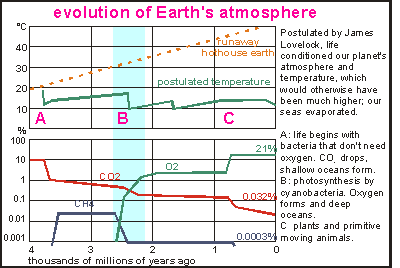 Independent
scientist James Lovelock, as part of his Gaia hypothesis, made us look
at the world as if it were a single organism. Lovelock observed that life
always changed the conditions of its own existence. Life evolved to make
life better and its environment more suitable for life itself. Organisms
steering the other way would simply not survive. As a result of evolution,
the planet acquired the atmosphere we know now, and an ocean. As part of
its ability to change its environment, life has also acquired primitive
means to regulate the temperature of this planet (green sawtooth line).
Otherwise, due to increasing solar radiation, the temperature would at
least have been 50-60ºC (orange dotted line). Independent
scientist James Lovelock, as part of his Gaia hypothesis, made us look
at the world as if it were a single organism. Lovelock observed that life
always changed the conditions of its own existence. Life evolved to make
life better and its environment more suitable for life itself. Organisms
steering the other way would simply not survive. As a result of evolution,
the planet acquired the atmosphere we know now, and an ocean. As part of
its ability to change its environment, life has also acquired primitive
means to regulate the temperature of this planet (green sawtooth line).
Otherwise, due to increasing solar radiation, the temperature would at
least have been 50-60ºC (orange dotted line). |
The idea is that a small amount of water formed after cooling (the archean sea, perhaps 100-300 m deep in small seas here and there, the amount of water necessary for changing CH4 to C to CO2 and NH4 to N2 and SO4 to S, and an atmosphere consisting largely of nitrogen, carbon dioxide, methane and hydrogen - a mixture lethal to organisms alive today. Imagine this ocean as a shallow, warm, acidic, black cesspool full of stinking bacteria. The water for this ocean came from the earth's crust, and from sunlight dissociating CO2 in the upper atmosphere. The formed oxygen could then bind with the escaping hydrogen to form water. The warm ocean evaporated much water vapour and it rained torrentially. Because no living organisms were found on the land, erosion must have been very intense, resulting in enormous amounts of run-off, containing sediment and nutrients.
For more water to form, the hydrogen, escaping from the planet, had to be bound with more oxygen. But oxygen was available only as carbon compounds in carbon dioxide. Only life, in the act of photosynthesis, is able to split carbon and oxygen from carbon dioxide in large quantities. The carbon that formed, was buried underground and for each atom of carbon, two molecules of water were formed. The cyanobacteria capable of doing this, formed about 3600 My ago. By 2500 My ago, the oceans would have formed and the atmosphere made suitable for higher organisms than bacteria, the prokaryotes. The light blue band in the diagram is perhaps all it took to create the bulk of our oceans. By 570 My ago, the Cambrian period started, with plants and moving animals in recognisable forms. By that time, the atmosphere had evolved much to what we have today.
As scientists are analysing ratios of elements in ancient rocks, they are piecing together evidence for the composition of Earth's ancient atmosphere and its temperature, and with it the answer on how our atmosphere, climate and oceans formed.
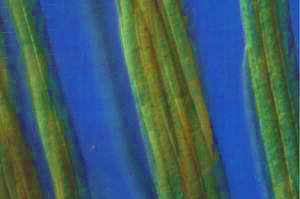 |
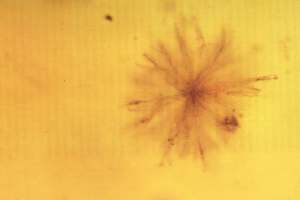 |
References, available from the Seafriends
Library:
Allaby, Michael: Guide to Gaia. 1989.
Gribbin, John: Hothouse Earth, the Greenhouse Effect
& Gaia.1990.
Joseph, Lawrence E: GAIA, the growth of an idea.1990.
Lovelock, James E: GAIA, a new look at life on earth.
1987.
Lovelock, James E: The ages of GAIA.1988.
Schneider, Stephen H and Randi Londer: The Co-Evolution
of Climate and Life.1984.
Tectonic plates
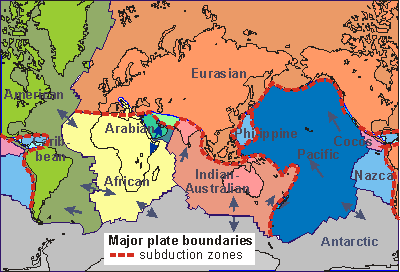 As
recently as 40 years ago, continental drift became an accepted theory.
Since then, scientists in many disciplines have found overwhelming evidence
of the way continents move. As
recently as 40 years ago, continental drift became an accepted theory.
Since then, scientists in many disciplines have found overwhelming evidence
of the way continents move.
One of the puzzles was that on the ocean floor, the rocks never seemed to grow older than about 100 million years, whereas on land they have been dated back to 3800 million years. Mysterious ridges exist in the centres of the Atlantic Ocean and the Pacific Ocean. Along 'rims of fire', mountain ridges and active volcanoes are found. Similar rocks, fossils and organisms are found on opposite sides of oceans. It wasn't until all these facts were brought together that scientists realised that the seafloor is gradually disappearing and that the continents are drifting. |
The map shows the tectonic plates relative to the positions of the continents.
The red dotted lines are mountain ranges and rims of active volcanoes.
Here the plates collide, causing mountains to rise and volcanoes to spew
liquid lava. By contrast, along the mid-ocean ridges, the seafloor is spreading,
creating new oceanic crust.
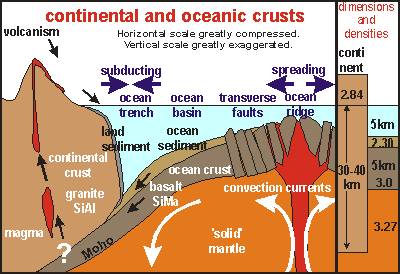 The
diagram shows how oceanic crust is produced in areas where the seafloor
is spreading, while it is pushed underneath continents (subducting) elsewhere.
On a continuous basis new ocean crust is created while thousands of kilometres
further, the crust is subducted and absorbed by the hot mantle. The
diagram shows how oceanic crust is produced in areas where the seafloor
is spreading, while it is pushed underneath continents (subducting) elsewhere.
On a continuous basis new ocean crust is created while thousands of kilometres
further, the crust is subducted and absorbed by the hot mantle.
The Earth's soft mantle consists of hot, semi-liquid stone, which circulates very slowly by way of convection currents. Where these currents move upward, undersea volcanic activity occurs and lava pours out, immediately solidifying in the deep sea. As the crust spreads, it cools further, shrinks somewhat, breaks and slumps into ridges that run parallel with the spreading zone. The speed of plate movement is about equal to a growing fingernail but may differ from place to place (3-15 mm/year). On the ocean floor no rocks have been found older than 180 million years. |
The rocks start to weather and erode, depositing ocean sediment on top
of the ocean crust. Light particles from the land, such as clay are often
blown far out into sea and settle on the sea floor. Sea organisms with
hard skeletons rain down from the plankton-rich layers above. Metals such
as manganese, form nodules on the sea bottom. The ocean sediments are a
mix of many of such ingredients.
In the subduction zone, the ocean crust is pushed underneath the continent,
gradually melting back into the mantle. In the process, sediments from
the land are drawn under too. Due to heat from compression, some of the
material may melt a path through the continental crust, causing volcanic
activity. New continental crust is formed.
The rightmost diagram in above picture shows how both continents and
ocean crust float in balance on the mantle. The continental crust, which
was formed before the oceans, consists of granite, a silica-alumina (SiAl)
rock and is 30-40 km thick. It is lighter (density 2.84) than the mantle
(density 3.27). The weight of the continent equals the displaced weight
of the mantle. The ocean crust, about 11 km thick, is made of silica-magnesia
rock (SiMa) and is heavier (density 3.00) than the continental crust but
lighter than the mantle. It floats also in balance on top of the mantle:
water (density 1.03) + sediment (density 2.30) + crust (density 3.00) =
displaced mantle (density 3.27).
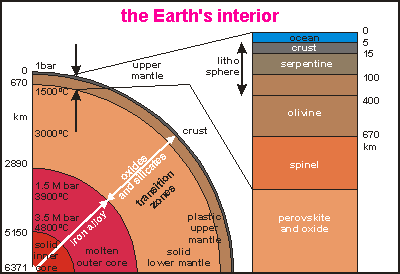 A
new view of Earth's interior A
new view of Earth's interior
In order to explain very deep earthquakes 300-600 km down, scientists have begun to think that the whole mantle is solid. Movements within it occur due to the rock changing its structure under the influence of heat and pressure. (The pressure at 100km depth exceeds 30,000 times atmospheric pressure). The rocky material which comprises the lithosphere of the earth is special, because the rocks contain water, which is trapped within the crystal structure of the rocks themselves. These special 'hydrated minerals' have the ability to slide against each other. On other planets, where the minerals of the lithosphere do not contain water, the lithosphere does not flow and hence these planets do not have plates moving on the surface. As the crust is pushed down into the mantle, the rock collapses into different crystal structures, producing earthquakes in the process. Likewise, in convection zones, the rock can expand and 'flow' in a similar way. The drawing shows the various layers now thought to exist within our planet. The heavy iron core is thought to consist of a solid part in the very centre, surrounded by a molten outer core. The lower mantle, consisting of oxides and silicates, may also be less liquid than originally thought. The upper mantle which is more finely layered as shown on right, consists mainly of magnesium-iron silicates (Mg, Fe)2 SiO4 in various crystal forms. How is it possible that the inner part of the Earth, thought to be 4800 degrees C, is solid? At this temperature, iron is well and truly liquid. The answer must be sought in the two opposing forces that increase with depth: temperature and pressure: whereas temperature makes stuff more liquid, pressure does the opposite. The heat in the core is produced by radioactive heavy elements. For instance, Uranium-238 has a half-life of 4.5 thousand million years (Gy), so about half of it is still left over since Earth formed. Thorium-232 has a half life of 14 Gy, so the furnace deep inside the planet will be producing heat for a very long time to come. Heat radiates out, while cooling in the process. Whereas heat makes matter liquid, pressure, which increases formidably, tends to make matter solid. These two opposing forces cause alternating zones of solids and liquids. A pressure of 3.5 million bar as it exists in the core, is very hard to imagine. A car tyre contains 2 bar pressure (200 KPa); a dive cylinder 200 (20MPa); most concrete cracks at 500 bar (50 MPa). (Source: H W Green II: Solving the paradox of deep earthquakes. SciAm Sep 1994) |
| layer | depth km | thickness km | state | composition | density | temp ºC |
| crust
continental |
0-65 | 45 | solid | silicates rich in magnesium and aluminium | 2.67 | -40 - 1000 |
| crust oceanic | 0-10 | 7 | solid | silicates rich in magnesium and iron | 3.0 | 0-1100 |
| mantle | 45-2900 | 2855 | solid & mobile | magnesium-iron silicates | 4.5 | 1100-5000 |
| outer core | 2900-5300 | 2400 | liquid | iron, nickel | 11.5 | 5000-6000 |
| inner core | 5300-6370 | 1070 | solid | iron, nickel | 13.0 | 6000-6600 |
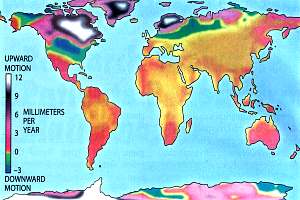 Vertical
movements of continents due to ice ages Vertical
movements of continents due to ice ages
During the ice ages, the ice was in places over one km thick, causing the continents to sink further into the mantle. After the ice ages, the continents slowly bobbed up again, a process that takes thousands of years, and that is still happening today in some places.The map shows clearly how Canada, Greenland and Scandinavia are still rising from the loss of the heavy glaciers some 20,000 years ago. In the process of continents tipping, some places are moving down. For example, Holland is sinking, which the Dutch are very well aware of. (Source: W R Peltier & A M Tuschingham, Univ Toronto in David Schneider: The rising seas, SciAm Mar 1997) |
| How did scientists puzzle this story together?
Nobody has ever drilled a hole into the Earth's mantle (the deepest drill hole is about 10 km). Much of the structure under ground was gained from the quest for oil. Geologists detonate explosives to 'ping' the earth, like a depth sounder would. Arrays of microphones receive the reflected sound, while computers construct a picture from these signals. Underground nuclear tests have provided geologists with a wealth of opportunities. Waves also radiate out from earth quakes and these are very strong at times, while originating at depths, not reachable by humans. All around the world a network of seismic stations has been built to record earthquakes and detonations from nuclear weapons. |
It is known that sound travels faster in a denser medium. From measurements
of the speed of sound, the densities of the various layers could be calculated.
Underneath the continental crust, the Mohorovicic Discontinuity or Moho
(Yugoslav geologist Andrija Mohorovicic, 1906) was discovered, marking
the boundary between the solid crust and the upper mantle at about 40km
depth.
In 1926, the German scientist Beno Gutenberg, discovered another discontinuity,
about 150 km deeper down under continents and 70 km under the sea, marking
the boundary with the deeper plastic mantle. It is now accepted that the
tectonic plates extend 70 km deep, the lithosphere (Gk lithos =
stone), which float on a softer mantle, the asthenosphere (Gk asthenes
= weak).
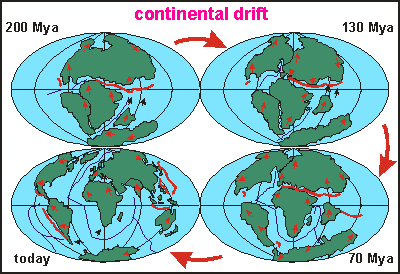 How
did the continents drift? How
did the continents drift?
Why the continents suddenly started to drift about 300 million years ago (The age of Earth is about 4500 million years), is a puzzle (also see box). Until that time, the continents formed one land mass, named Pangea (Greek pan, pas = the whole; geo = earth). The first split between the northern half, now named Laurasia (Europe, North America and Asia), and the southern half, named Gondwanaland (South America, Africa, India, Antarctica, Australia and New Zealand), began 300 million years ago (300Mya). It is possible that the gap between the two continents was sufficiently large to form the first circumglobal sea, allowing ocean currents to travel around the world, resulting in a warm equitable climate everywhere. In any case, the seas that formed between the splitting continents, were warm and rich in nutrients and marine life, laying down all the mineral oil we now mine. These changes must have been accompanied with severe climate changes and changes in vegatation, accompanied by massive erosion. Click here for a larger version of this map. |
On the map one can see how the continents travelled, propelled by ocean plates that have changed shape enormously. The red curves are areas of collision, whereas the blue lines are those where the seafloor was spreading. Where the continents collided, high mountain ridges were formed, such as in Europe (colliding with Africa): The Pyrenees, the Alps and more. An interesting case is India which travelled all the way north to collide with Asia, forming the Himalayan mountains. Australia broke away from Antarctica at a later stage, pulling New Zealand with it. But how did scientists puzzle this story together?
The secret lies in a weak property of rock: its magnetic field. Inside
many rocks is found the element iron, a very common element on this planet.
Iron and some of its oxides can be magnetised by the magnetic field of
Earth. This won't happen as long as the rock is liquid, but by the time
it cools sufficiently to become rock, the Earth's magnetic field is 'frozen'
in place. Geologists drill deep sampling cores and analyse the magnetic
field orientation. To make matters worse and easier at the same time, the
magnetic poles have reversed several times and they have been wandering
around somewhat. So the data needs to be corrected by what is known about
the oscillations in the Earth's magnetic field. But at the same time, the
field reversals are also convenient time markers to age the layers in the
core samples.
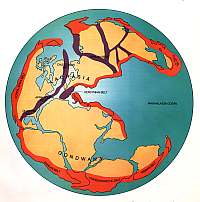 The
continents may have been drifting for much longer The
continents may have been drifting for much longer
New evidence with respect to tectonic plate movements, suggests that the continents may always have been drifting apart, then together again. When continents collide, they form folded mountain ranges. A number of such ranges could be explained only by assuming that the continents have collided once or twice before. A difficulty in studying old mountain ranges is that they have all but completely eroded away. But as scientists are drilling more holes, their knowledge pieces together the continental crust movements dating back to 500 million years. In the drawing of the world map with all continents joined together, the red mountain ranges could be explained by subduction of ocean plates, uplifting the continents at their margins. Yet some of these ranges are folded extensively. The purple ranges are all folded and are thought to have occured by the continents colliding towards the Pangea configuration. On left the mountain range from Ouachita belt, through Appalachian belt and the Caledonian belt over Iceland, Scandinavia and Greenland. The Hercynian belt runs through the Pyrenees and the Alps. The Uralian belts criss-cross through Asia and Siberia.
|
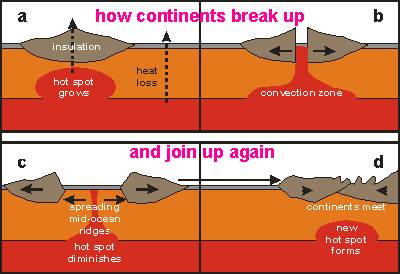 A
possible mechanism A
possible mechanism
But what could the mechanism for such movement be? A simple explanation is shown in the four drawings on right. It is generally accepted that the crustal movement is caused by convection currents, originating from differences in temperature between spots in the liquid mantle. The Earth cools its interior by leaking heat to the outside. Where the crust is thin, such as underneath oceans, heat is lost more easily, resulting in a cooler area. But since continents are four times thicker, they also insulate better. A hotspot could appear underneath a large continental slab. As the solid mantle heats up, the coninent is bulged up and cracks. It allows a convection zone to form, pushing the broken halves apart and ending up as a spreading mid-ocean ridge. At some other place on the globe, continents ae pushed together again, and a new hot spot is formed, while the old hot spot shrinks. Continents break up again and reverse their travel. |
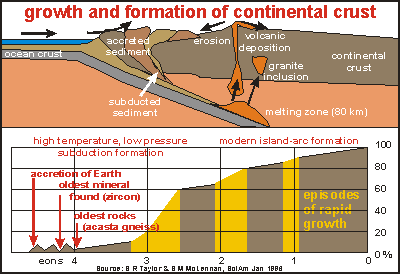 Growth
and formation of continental crust Growth
and formation of continental crust
One of the remaining problems is that land erosion happens so fast, that all the continents should have disappeared below sea level, a very long time ago. Particularly in the azoic (no-life) era (till 2.5 eons ago) without any cover on the land, erosion would have been very high. By measuring the very low concentrations of the rare-earth elements (EER or Lantanides, see the Periodic Table of Elements), geologists discovered that the sedimentary rocks, originating from mud washing into the oceans, represent a very good average of the composition of the continental crust. The oldest mineral (zircon) is found in sedimentary rock in Australia and is 4.2 eons old. In north-west Canada, the Acnasta Gneiss formation yielded the oldest rock (granite) that was not formed from sediment. Now that a very large number of measurements have been made on sedimentary rocks of various ages, the actual volume of the continental crust can be plotted. In the figure on right, the bottom graph shows how the volume of crust has been growing, sometimes slowly, sometimes more rapidly. The time scale is in eons (thousand million years). Almost immediately after Earth accreted from particles and meteors, a small amount of crust was formed and during the first eon, this amount did not increase very much (erosion was very high). Only when the ocean plates started moving, was continental crust formed, first fast because the interior of Earth was hotter, then more slowly. The crust that formed in the first episode of fast growth (granite?), is different from later rocks, perhaps due to the possibility that oceanic crust was recycled much faster than today. (due to the presence of a deep ocean??). The top diagram shows a slab of oceanic crust subducting under a continent. By pushing sediments up, the continent grows from accretion. It also acquires more volume from volcanoes. It is now thought that sedimentary rock melts, not only from friction but mainly from the amount of water it contains, which acts as a flux additive in a foundry, inducing first the sedimentary rock to melt and then the continental rock as it moves upward to the surface. Magma chambers do not always reach the surface but can convert to granite, which is included as part of the continental crust. Current oceanic crust forms mainly by the eruption of basaltic lava along a globe-encircling network of mid-ocean ridges. More than 18 million cubic km of rock are produced this way, each year. The simple concept of continents made from granite, formed when the mantle was liquid, while staying the same size, needs to be changed in the light of these new findings. Note that the first rapid growth of continental crust suggests that oceans were formed just before 3 eons ago. Source: S R Taylor & S M McLennan: The evolution of continental crust. Sci Am Jan 1996. p76-81 |
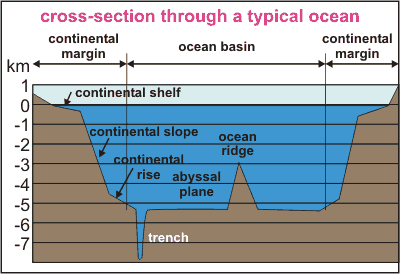 Naming
the features of the ocean basins Naming
the features of the ocean basins
In this drawing of a typical ocean profile, the vertical scale has been exaggerated, to better illustrate the ocean's shape.Where the land meets the water, continents start with a gradual slope down to about 200m depth. It is called the continental shelf. For various reasons, this is the most productive part of the ocean. Beyond the continental shelf, the seafloor dips down more steeply (the continental slope) until it becomes more gradual again (the continental rise). Some continents are flanked by deep trenches. Where the continental rise ends (a vague boudary), the abyssal plane starts (Gk a = no; bussos = depth; bottomless). Where the ocean's floor is spreading, an ocean ridge is found, flanked by large fracture zones. |
| A three-dimensional map of the oceans
Ever since people were sailing the oceans, attempts have been made to map them, but the deep oceans, often exceeding 5000m depth, were impossible to plumb until electronic depth sounders were invented. Two scientists in particular, gathered together the sounding data and drew up new and historic maps of the sea floor (see below). In the International Geophysical Year, scientists from all nations made a concerted effort to co-operate in their study of the planet. Since then, the study of our oceans has been pursued with rigour.
|
| Ocean floor mapping from space?
In 1978, an experimental satellite was launched to study the oceans. One of Seasat's instruments was a radar altimeter, able to measure the ocean's surface from an altitude about 500 miles up, with a precision of 5-10 cm. Surprisingly, the surface of the ocean proved to be curving and dipping, often by as much as 10m up and down (for 5000m bottom relief). When mapped, the dips corresponded to dips in the sea floor and the bumps to sea mounts and ridges. The precision of the measurements allowed computers to make precise and detailed maps of the entire world's ocean floors. The principle that causes the unevenness of the ocean's surface, is gravity. A water particle is pulled towards the centre of the Earth by its gravity but when it is close to a sea mount, it is also pulled towards the sea mount's mass. As a result, water is piled up above sea mounts and ridges and dipped down above trenches. Seafarers have never been able to notice this because it does not affect the ship's course, nor can it be seen or felt.
|
| Main ocean trenches
a Aleutian b Kuril c Japan d Mariana e Philippine f Java g Tonga, Kermadec h Peru-Chile |
Main mountain ridges
1 Andes 2 Atlas 3 Alps, Apenines, Carpathians 4 Caucasus 5 Turkey, Iran, Afganistan 6 Himalayas 7 Tienshan, Sayan, Stanovoy 8 Rocky Mountains |
 |
| Oceans and seas of the world
Over 70 oceans and seas are known in the world, including straits, gulfs and bights. In the table and map below, only the largest are shown. |
|
|
|||
|